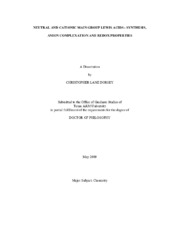| dc.contributor.advisor | Gabbai, Francois P. | |
| dc.creator | Dorsey, Christopher L. | |
| dc.date.accessioned | 2010-07-15T00:13:59Z | |
| dc.date.accessioned | 2010-07-23T21:45:20Z | |
| dc.date.available | 2010-07-15T00:13:59Z | |
| dc.date.available | 2010-07-23T21:45:20Z | |
| dc.date.created | 2009-05 | |
| dc.date.issued | 2010-07-14 | |
| dc.date.submitted | May 2009 | |
| dc.identifier.uri | https://hdl.handle.net/1969.1/ETD-TAMU-2009-05-766 | |
| dc.description.abstract | The primary goal of this research concerns the synthesis and characterization of hybrid
main group Lewis acids. Initially, the focus of this work was on the synthesis of
derivatives possessing unusual bonding interactions enforced by a rigid 1,8-
naphthalenediyl scaffold. After discovering a route to a new dilithio reagent, silicon
based derivatives featuring R3Si-F->CR3
+ and R3C-H->SiFR3 interactions of 2.703(2)
and 2.32(2) Angstrom respectively were successfully synthesized and fully characterized.
Another hybrid Lewis acid based on the 1,8-naphthalenediyl scaffold that was studied
was a trinuclear B2/Hg Lewis acid. This molecule has been shown to bind two fluoride
anions sequentially, and the binding events can be followed by differential pulsed
votammetry.
The final part of this work concerns the reactivity and redox behavior of main group
systems. It has been shown that the p-phenylene linker in 4-dimesitylboryl-1-
diarylmethylium benzenes effectively reduces electrochemical communication between
the carbocation and borane moieties when compared to systems without the linker.
Reduction of these species produces a derivative whose EPR signal is only slightly
influenced by the ^11 B center. These findings have been further substantiated by
theoretical calculations. Finally, the redox properties of alpha-phosphonio- and alpha- phosphonyl-carbocations have been studied. Chemical reduction of both species leads to
a predominately carbon centered radical with coupling to the ^31P center of 18 and 19.7 G
respectively. The alpha-phosphonio carbocations, however, also undergo ligand exchange
reactions with pyridine derivatives suggesting that these species can also be referred to as
ligand stabilized carbodications. | en |
| dc.format.mimetype | application/pdf | |
| dc.language.iso | eng | |
| dc.subject | Lewis Acid | en |
| dc.subject | Anion Complexation | en |
| dc.title | Neutral and Cationic Main Group Lewis Acids - Synthesis, Anion Complexation and Redox Properties | en |
| dc.type | Book | en |
| dc.type | Thesis | en |
| thesis.degree.department | Chemistry | en |
| thesis.degree.discipline | Chemistry | en |
| thesis.degree.grantor | Texas A&M University | en |
| thesis.degree.name | Doctor of Philosophy | en |
| thesis.degree.level | Doctoral | en |
| dc.contributor.committeeMember | Darensbourg, Marcetta Y. | |
| dc.contributor.committeeMember | Bergbreiter, David E. | |
| dc.contributor.committeeMember | Pellois, Jean-Philippe | |
| dc.type.genre | Electronic Dissertation | en |
| dc.type.material | text | en |


